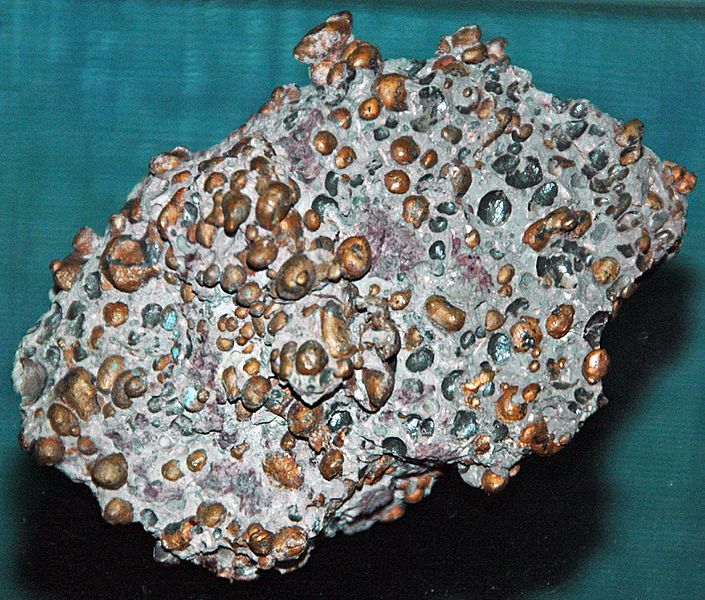Image: Cupriferous amygdaloidal basalt (Mesoproterozoic, 1.05-1.06 Ga; Wolverine Mine, Kearsarge, Upper Peninsula of Michigan, USA) (17323753605)

Description: Cupriferous amygdaloidal basalt ("shot copper") from the Precambrian of Michigan, USA. (public display, Seaman Mineral Museum, Michigan Technological University, Houghton, Michigan, USA) A mineral is a naturally-occurring, solid, inorganic, crystalline substrance having a fairly definite chemical composition and having fairly definite physical properties. At its simplest, a mineral is a naturally-occurring solid chemical. Currently, there are over 4900 named and described minerals - about 200 of them are common and about 20 of them are very common. Mineral classification is based on anion chemistry. Major categories of minerals are: elements, sulfides, oxides, halides, carbonates, sulfates, phosphates, and silicates. Elements are fundamental substances of matter - matter that is composed of the same types of atoms. At present, 118 elements are known (four of them are still unnamed). Of these, 98 occur naturally on Earth (hydrogen to californium). Most of these occur in rocks & minerals, although some occur in very small, trace amounts. Only some elements occur in their native elemental state as minerals. To find a native element in nature, it must be relatively non-reactive and there must be some concentration process. Metallic, semimetallic (metalloid), and nonmetallic elements are known in their native state as minerals. Copper is the only metallic element that has a "reddish" color - it’s actually a metallic orange color. Most metallic elements, apart from gold & copper, are silvery-gray colored. Copper tends to form sharp-edged, irregular, twisted masses of moderately high density. It is moderately soft, but is extremely difficult to break. It has no cleavage and has a distinctive hackly fracture. The native copper-bearing rock shown above comes from northern Michigan's Portage Lake Volcanic Series, an extremely thick, Precambrian-aged, flood-basalt deposit that fills up an ancient continental rift valley. This rift valley, analogous to the present-day East African Rift Valley, extends from Kansas to Minnesota to the Lake Superior area to southern Michigan. Unlike many flood basalts (e.g., Deccan Traps, Siberian Traps, Columbia River), the Portage Lake only filled up the rift valley. The unit is exposed throughout Michigan’s Keweenaw Peninsula, in the vicinity of the towns of Houghton & Hancock. The Portage Lake succession thickens northward through the Keweenaw, up to >5.5 km worth of section in places. The dominant rock type is basalt - vesicular basalts, for the most part. Most of the original vesicles (gas bubbles) have since been filled up with a wide variety of different minerals. A vesicular basalt that has had its vesicles filled up with minerals is called an amygdaloidal basalt (try saying that five times quickly). Keweenaw amygdaloidal basalts have long had significant economic importance because native copper (Cu) is one of the more common vesicle-filling and fracture-filling minerals. Native silver (Ag) is sometimes closely associated with copper. Copper and silver mineralization occurred during the late Mesoproterozoic, at 1.05 to 1.06 billion years ago. The Portage Lake host rocks are 1.093 to 1.097 billion years old. This rock is the most amazing cupriferous amygdaloidal basalt sample I've ever seen. The morphology of each copper-filled vesicle is easily seen. Locality: Wolverine Mine, Kearsarge, Upper Peninsula of Michigan, USA
Title: Cupriferous amygdaloidal basalt (Mesoproterozoic, 1.05-1.06 Ga; Wolverine Mine, Kearsarge, Upper Peninsula of Michigan, USA) (17323753605)
Credit: Cupriferous amygdaloidal basalt (Mesoproterozoic, 1.05-1.06 Ga; Wolverine Mine, Kearsarge, Upper Peninsula of Michigan, USA)
Author: James St. John
Usage Terms: Creative Commons Attribution 2.0
License: CC BY 2.0
License Link: https://creativecommons.org/licenses/by/2.0
Attribution Required?: Yes
Image usage
The following page links to this image:

